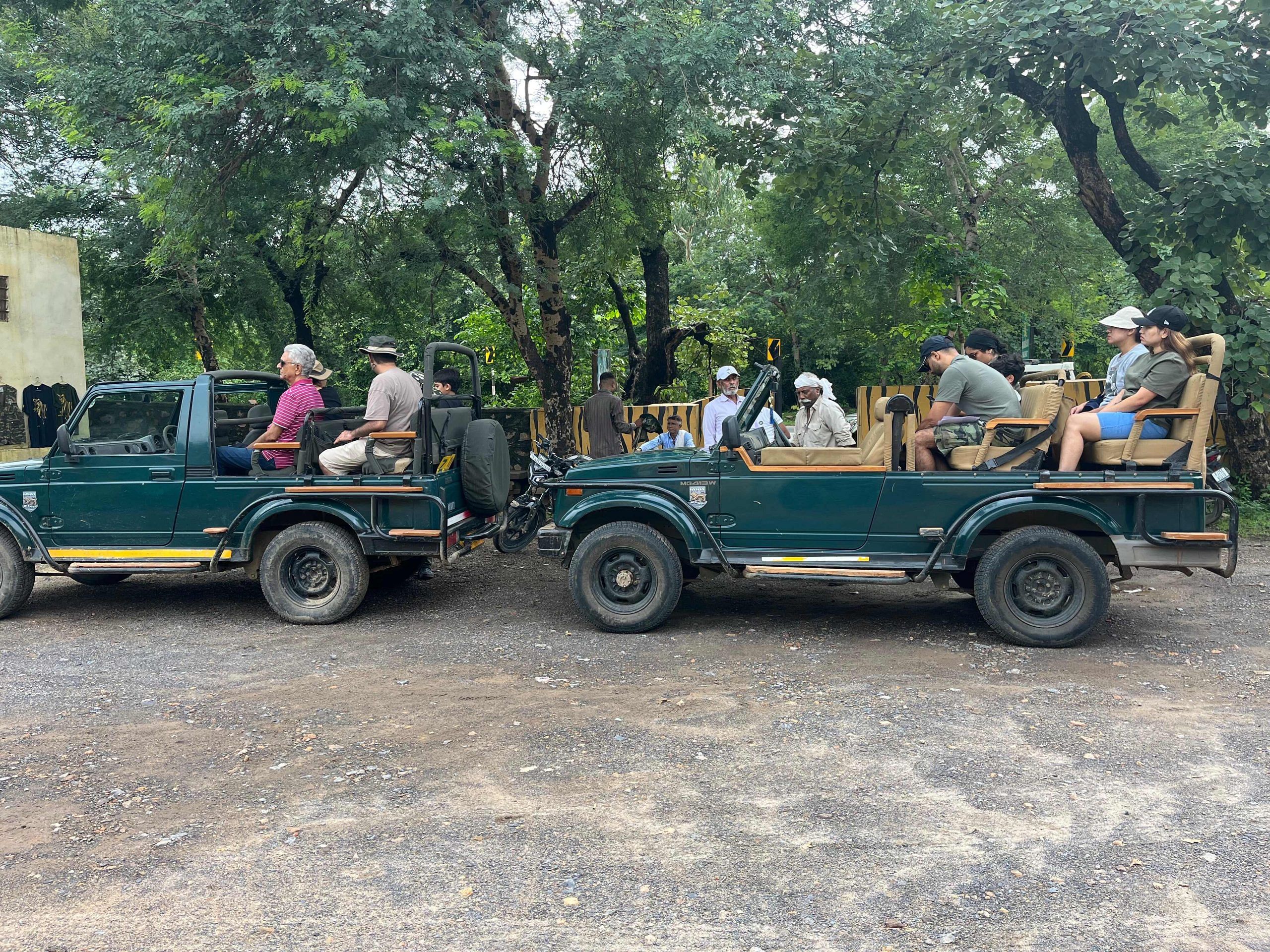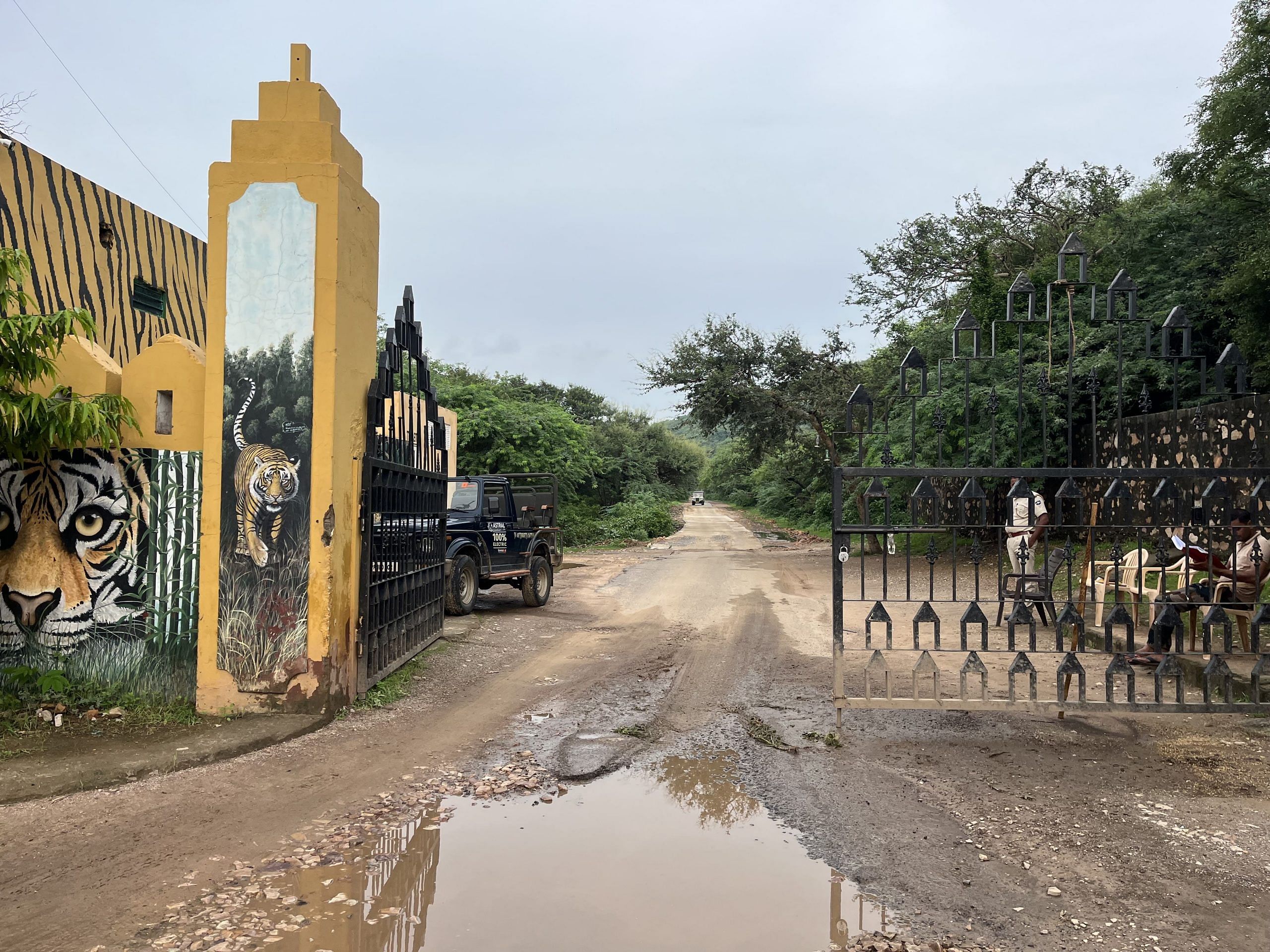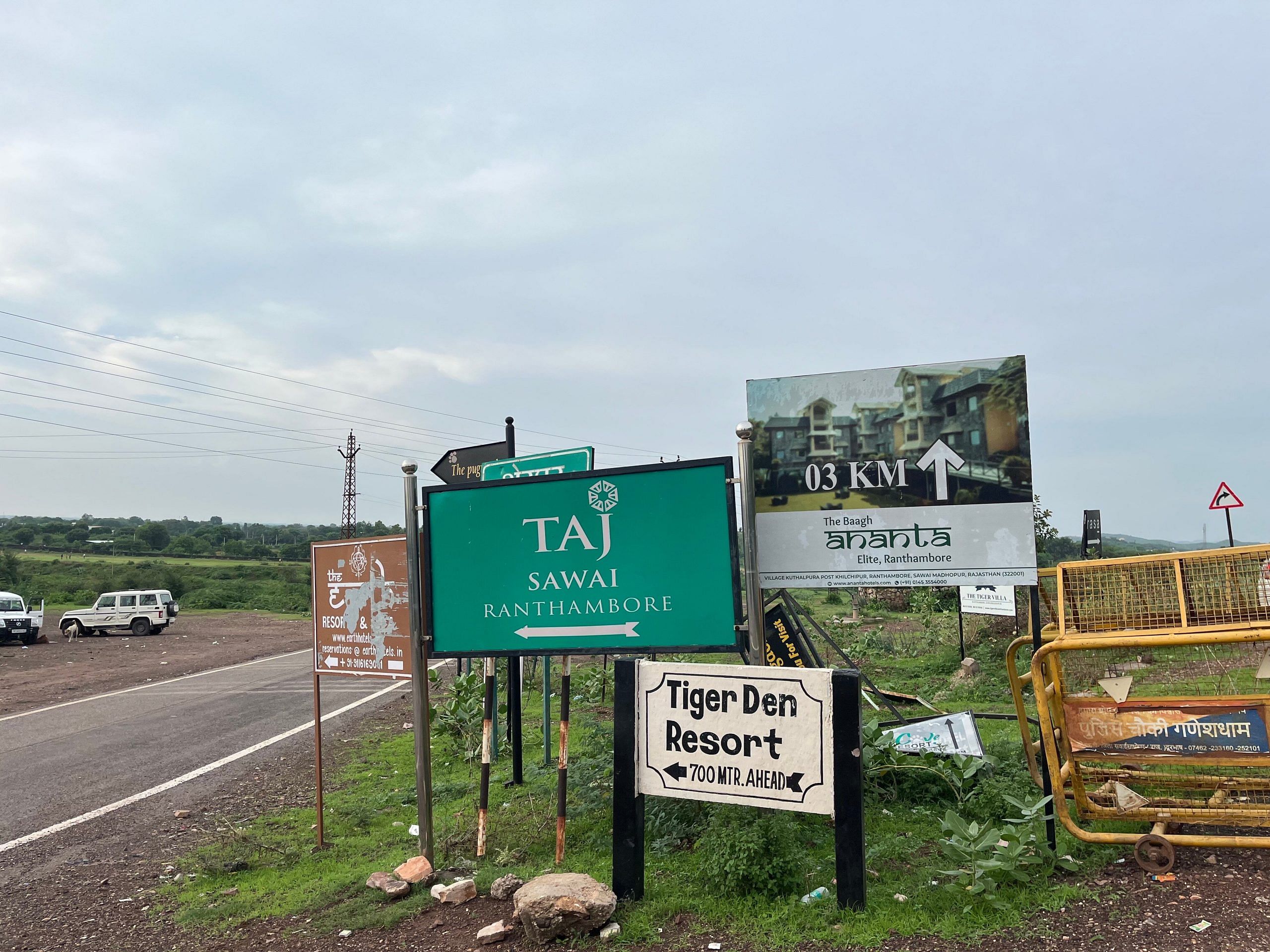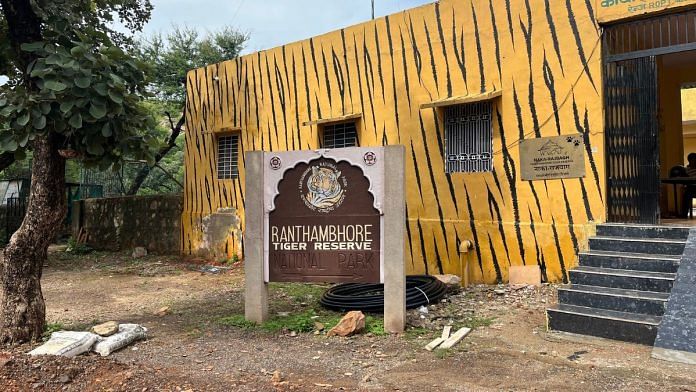Sawai Madhopur: Wildlife filmmaker Toby Sinclair has a single word to describe his first visit to Ranthambhore in 1980: quiet. Now, a vast majority has another adjective in mind: raucous. The sounds of the jungle have been subdued by the sighs and screams of tourists.
The Ranthambhore National Park in Rajasthan became the best practices model of tiger conservation after a particularly horrific phase of poaching crisis. Conservationists such as the late Valmik Thapar made Ranthambhore into an invincible template that was replicated across India. Today, it is a victim of its own success story. Too many tigers, too many tourists, and a mushrooming infrastructure on steroids.
And nobody was paying attention to upgrading or tweaking that success template.
From the glory of revival — tigers basking in chhatris and the manufactured folklore of its tiger queens — Ranthambhore is now facing a litany of crises. Just in the last three months, three people have been killed in tiger attacks near the tourist hotspot of Jogi Mahal. A recent poaching probe has further raised questions about the safety of this now-sacred animal. For its powerful, camera-toting devotees, there’s plenty to be up in arms about. The park’s popularity has come at a hefty price. With pressure mounting over the tourism frenzy, officials are now contemplating a zoo-like space outside the forest — a bid to satiate tourist hunger.
When Sinclair began working on documentary films for the BBC in the ’90s, there were only a smattering of people going in and out of the park. Now, the tiger reserve, the jewel of Indira Gandhi’s Project Tiger, stands transformed; practically unrecognisable to those who’ve been visiting it for decades.
Tourism is in danger of smothering the park. It’s out of control in and around Ranthambhore
– Wildlife filmmaker Toby Sinclair
A tourist launches a plastic bottle outside a canter and refuses to pick it up. A guide snatches a peacock feather off the bird, and tigers jostle for space alongside their human compatriots — as well as their very own. From 18 tigers in 2006, Rajasthan now has over 123, according to Tiger Watch. The state’s tiger population has been replenished by Ranthambhore. Every few feet is a hoarding for a hotel.
“Tourism is in danger of smothering the park. It’s out of control in and around Ranthambhore,” said Sinclair, who has also worked as a consultant on several safari camps in India. “Commerce is more pertinent than conservation, much to the detriment of the park.”

Luxury resorts, some of which cost upward of Rs 1 lakh a night, dot the core zones of the park, as well as the critical tiger habitats (CTH). There’s a league of conservationists who have turned entrepreneurs with commercial interests. There’s both the high-end, as well as the lowbrow. What they have in common is the tiger — a motif which is splattered across the town of Sawai Madhopur.
K Ullas Karanth, conservation zoologist, Emeritus Director of the Centre for Wildlife Studies, and author of Among Tigers, calls it a problem of “overmanaged parks”. These are being plagued by the possibility of too many tigers — the price of success.
“Tiger densities beyond 10-20 animals per 100 square kilometers, which we are seeing in many overmanaged parks, are unnatural,” Karanth said. “As are the prey densities that support them.”
ThePrint received varying estimates of the tiger population at Ranthambhore, ranging from 73 to over 80.
‘Tiger cult’
There’s something like too much love too — the affinity for the Ranthambhore tigers that teeters on the edge of obsession. Sawai Madhopur is home to an ice cream parlour named after Riddhi and Siddhi, part of the current lot of famous tigresses. The hoarding outside a memorabilia store has a tiger paired with Salman Khan.
Valmik Thapar, who through the films he made and the dozens of books he authored, turned Ranthambhore’s tigresses into individual spectacles and ‘saving the tiger’ became the order of the day. Each description, each sighting is electric. Through his work, Thapar rendered the tiger alive, accessible.
“I continued to click while walking a few paces with her, my heart pounding. For me this was it. The magical forests of Ranthambhore had produced their finest vision,” writes Thapar in Living with Tigers, which has a chapter dedicated to each of the tigresses who’ve influenced his life.
According to Karanth, in the initial years — the 80s and 90s — this benefited the park.
“The ‘popularity’ initially helped, but in more recent times it has done damage,” he said, while also referring to the formation of a “tiger cult.”
Also read: Patna University’s lottery appointment tries to fix nepotism. It isn’t just a Bihar problem
Celebrity tigers
Yadvendra Singh has worked as a guide in Ranthambhore since 1992, 12 years after it was declared a national park. It was the foreigners that drew him in — the idea of explaining the forest to an eagle-eyed, white-skinned wildlifer. But as the decades passed, this changed.
Now, the kind of tourist coming to Ranthambhore has changed. The Delhi-Vadodara expressway has made it imminently accessible, making the national park a mere four hours away from the national capital. It has led to the dawn of day-trippers, who are more fixated on hype and content creation.

“Before Covid, we had way more foreigners than Indians. And back then, even up till 2005 or 2006, Indians didn’t know anything about wildlife,” Singh said. “It was the foreigners who understood what a guide was. That’s how we started learning about animals.”
He added that for many tourists, coming to the park is now simply a jaunt, an “outing.”
What separates Ranthambhore from India’s other 105 national parks is the nature of the forest — the dry deciduous landscape which makes it easier to spot tigers, and the cinematic settings in which they can be observed. The tigresses of Zone 3 in particular — which include Machli and her granddaughter Arrowhead, who recently passed away — began to be regarded as the queen of the lakes. A narrative was constructed, and these tigers, which were frequently spotted and practically performed for tourists, became celebrities.
“The number of tourists is increasing day by day,” said Pramod Kumar Dhakar, Deputy Conservator of Forests (Tourism), Ranthambhore Tiger Project. “There’s a lot of pressure on us as the number of vehicles is fixed.”
According to the website, over 7 lakh people visited Ranthambhore in the 2024-25 season. Exactly 10 years ago, in 2014, the park played host to a little over 1 lakh visitors.
Meanwhile, the Kanha National Park in Madhya Pradesh welcomed around 2.6 lakh visitors this year, while Maharashtra’s Tadoba Andhari Tiger Reserve also attracts approximately 2 lakh people every year.
In order to ease the burden, officials are setting up a 40-hectare enclosed area outside the Ranthambhore forest, effectively a zoo, where they plan to relocate rescued animals. They’re awaiting clearance from the Central Zoo Authority and other official bodies.
Machli, who passed away in 2016, was at one point regarded as being the most filmed and photographed wild tiger on the planet.
Filmmakers also played a part in this. Other than Thapar, the late Aditya ‘Dicky’ Singh was also among the photographers and filmmakers who cast Ranthambhore’s tigresses out of the forest and into popular imagination.
“It’s to do with the [creation of] cultures. Tigers have come to signify vitality, beauty, ferocity and a particular type of grace,” said Mahesh Rangarajan, professor of Environmental studies and History at Ashoka University.
According to experts, the tigers in Ranthambhore, the park which is mostly for “rich tourists”, have received “disproportionate popularity” due to the place’s proximity to Delhi and its power circles.
Man-animal relationship
When the tigress Arrowhead passed away last month, a lot of tears were shed. At her cremation outside the park’s Zone 6, a guide recalled seeing tourists overcome with emotion — they were sobbing. It was as though a relative had passed away. The tigress was garlanded, draped in a white cloth. Another tourist suggested that a statue be erected in her memory.
The emotional attachment raises questions about the long-term consequences that could potentially dictate man-animal relationships, and the kind of weight it places on park and management authorities.
Arrowhead was presumably suffering from cancer. However, according to conservation biologist and tiger specialist Dharmendra Khandal, the tumour-like growth on her hind leg could be attributed to multiple causes, given that no bone marrow sample was taken. After the growth was spotted about a year ago, Arrowhead and her final litter of cubs began to be fed by the management through a process known as “live-baiting.” In May, three people were killed by Arrowhead’s cubs — a 7-year-old child, a ranger, and a guard at the fort.

The 7-year-old was snatched by Kankati, known to be the most “uninhibited”, in broad daylight, as he held his grandmother’s hand and was in the presence of 50 people.
“Trying to ‘save’ every individual tiger in such populations is foolish and unnecessary. This happens because cult-like obsession builds around particular tigers, which in turn drives to unscientific practices like artificial feeding, medical treatment, unjustified translocations to new areas, which do not help tiger population recovery at all because of all the conflicts and social tensions,” explained Karanth. “These cases and many other similar ones are a result of public pressure on wildlife managers who are themselves not trained in wildlife science seriously at all.”
Following the formation of national parks, a special order was passed in 1982 by Indira Gandhi that banned live-baiting.
However, in Ranthambhore, multiple tigers have been fed through live-baiting, which the authorities refer to as “supplementary feeding.”
“This is not something that happens in all reserves. The trend is now being resurrected,” said Khandal, adding that live-baiting is an age-old tradition which used to aid hunting. “It’s now being termed as supplementary food, and Arrowhead and her cubs were being fed in the tourist area.”
Khandal explained the last days of Machli, who was also given supplementary food. According to him, in her old age, she was also fed in core, tourist areas of the park — to the point she used to roar outside guard posts, expecting bait. There was also ranger corruption at play. Certain officers were pocketing money through the live-baiting by charging more money for the prey that was being delivered to the elderly tigress.
“Corruption and public pressure were motivations. Officers who refused to feed her were criticised,” he said. “This is our human tendency — we turn tigers into film stars.”
Khandal also added that it wasn’t like there was a tourist lobby advocating to keep these tigers alive through artificial means — but that it was simply how things evolved in Ranthambhore.
There is a single gate that is shared between the tigers, the pilgrims, and the tourists. And if recent history is anything to go by, they might be getting dangerously close. Behind this gate is the Ranthambhore Fort, the Ganesh temple, and the famed tiger territory — the three lakes: Rajbagh Talao, Malik Talao and Padam Talao.
While this has always been the lay of the land, according to a senior forest department official, what has changed is the number of tigers.

“The number of tigers have increased in that particular area. The maximum number of tigers were also sub-adults, who were in an experimental phase of life and were straying from their mother,” he said.
Since the attacks, two of Arrowhead’s cubs, including Kankati, have been shifted to Mukundra Hills, where they are living in close to captivity-like circumstances. Around that time, a guide received a text message from an NRI tourist based out of the US. “If Trump can build a border between the US and Mexico, why can’t authorities build a boundary between the park and the town?”
Also read: Delhi’s Nehru Planetarium is floundering. No director since 2021
An ‘overmanaged park’
By the end of 2024, there were 15 tigers in and around the tourist area of Jogi Mahal. Since then, two have been moved to Mukundra and Arrowhead has died. It raises questions about whether the resurgence of its population has been altogether too successful, and if the population density is too high.
“Like many other overmanged parks, it may be supporting tiger densities higher than what is natural for this habitat [at least in the most visited parts] because of habitat manipulations. One more example of meddling with nature without careful thought,” said Karanth.
The total area of the Ranthambhore park is about 1,700 sq km. Habitually, female tigers command about 15-20 kilometres of territory while male tigers are known to dominate larger areas — about 50-55 sq km.
“Going by this calculation, about 105 tigers can survive in the park. The area also depends on the prey base, water, human settlements.. All of these parameters have to be looked at, and only then can we decide whether it’s fit for tiger habitation,” said Khandal.
Wildlife biologist Ravi Chellam also asserted that tiger territory calls for a more nuanced understanding than a simple categorisation of area.
“There’s no single metric. Tiger numbers are also a function of habitat quality,” he said.
Last year, Ranthambhore made it to the headlines of several national dailies for cases of “missing tigers.” Officials estimated that at least 20-25 tigers were missing. The experts, which ThePrint spoke to, rubbished this idea. Karanth’s research has found that any sustainable tiger population loses about 15 to 20 per cent of its population — If there are 100 tigers in a particular population, 20 per cent will be “missing.”
There are several possibilities. Tigers are known to traverse massive distances, often in the span of a single night. They could have moved away owing to territorial fights. Or they simply could have died.
But in the case of Ranthambhore, there is always hype — and the tigers, particularly those in tourist areas, are now accountable to the public. Their every move is scrutinised, and every decision raises eyebrows.
“It’s a place where you hear more noises and sounds generated by man than the forest. In Kanha you can go hours without seeing another vehicle. In Ranthambhore, it’s virtually impossible to experience that feeling of isolation in the forest”
– a young wildlifer
The poaching problem
The poaching plague has a storied history in Ranthambhore. In the 1990s, a significant section of the tiger population was wiped out, due to poachers supplying bones to China, where they were used in medicine.
“Sometimes I feel guilty that I taught them to have faith in human beings,” Valmik Thapar is known to have said, referring to the fact that a number of tigers were shot “at point-blank range.”
Ranthambhore’s first field director, Fateh Singh Rathore, also a metonym for Ranthambhore’s success story, was nearly beaten to death by poachers.
According to experts and long term observers, from 40 tigers in the ’80s, the number had come down to about 10. Three decades later — after “save the tiger” became a rallying cry in Delhi following another crisis in the 2000s and poacher rehabilitation programmes took root — a raid conducted by Madhya Pradesh’s State Tiger Force, NGO Tiger Watch, and the Rajasthan forest department found skulls and bones of big cats in Madhya Pradesh’s Sheopur this month. A DNA analysis found that certain bones belonged to the tiger.
While the animals appear to have been killed between MP’s Madhav Tiger Reserve and Ranthambhore, the investigation is still ongoing. It is yet to be concluded whether or not the tigers belonged to Ranthambhore. A total of six people have been picked up — two are from Rajasthan’s Dausa, one from Tonk, two from Shivpuri, and one from MP’s Sheopur.
“We’ll have to wait for the genetic sampling. Only then will we be able to retrieve more information. Or we will have to wait for the culprits,” said a senior Rajasthan forest department official. “The investigation is ongoing.”
As for poaching itself, it isn’t a dirty slate that can be wiped clean. The demand persists.
“Major anti-poaching work has happened in Ranthambhore, but these people [poachers] are widely distributed. One NGO can’t do everything. It’s about demand,” said Khandal. “It’s a large community and when they see weakness brewing in the department — they strike.”
Also read: Does Kashmir’s history begin and end with Islam? First excavation to explore the unknown
More noise than roars
A young, reasonably avid wildlifer, having spent a chunk of his childhood years spotting the tigers in Ranthambhore, would now rather track his beloved big cat in Kanha.
“It’s a place where you hear more noises and sounds generated by man than the forest,” he said. “In Kanha you can go hours without seeing another vehicle. In Ranthambhore, it’s virtually impossible to experience that feeling of isolation in the forest.”
He described the Ranthambhore of today as akin to a zoo.
While, according to those who have frequented the park for decades, there is no disputing the park’s beauty and its striking terrain, there’s also a growing breed of wildlifers who would rather explore the slew of other tiger reserves the country has to offer, which are also growing increasingly popular.
It (Ranthambhore) might be popular, but whether it’s the best way for conserving tigers, or the best way of managing tourism — these are up for questioning
– Wildlife biologist Ravi Chellam
Uttarakhand’s Jim Corbett National Park, for instance, occupies a completely different space in wildlife imagination. Known for its dense forests — it has a far higher tiger density, but fewer celebrity tigers.
“It’s area specific. Chances of spotting the same tiger again and again are lower in Corbett. It’s a thickly forested terrain with 260 plus tigers,” said Saket Badola, field director of Corbett National Park. “If the area was similar, we’d probably be facing the same set of issues.”
Sinclair, whose first visit to Corbett was in 1976, made a critical distinction between Ranthambore and Corbett. Sawai Madhopur town existed before the national park was notified (although wildlife was always there), while in Corbett, a township of lodges has erupted in space around the reserve –– in spaces that used to be governed by tigers.
“The Sitabani reserve forest is an extension of Corbett, and you’ve put a knife in the middle of it in the form of tourism with lodges over the last 25 years blocking animal moment between park to the west, and the Reserve Forest across the Kosi River,” he said. A pre-Covid survey found that approximately 600 people could go into the park, but there are over 4,000 rooms that need to be filled.
In Sawai Madhopur too, the rooms are multiplying. A Marriott property on the edge of the reserve is coming up, which according to the tourism DCF, will have an astounding 150 rooms.

Ranthambhore is not necessarily the aspiration, the model for tiger conservation. But it is where each big cat receives a lot of attention.
The 1,800-sq km reserve also isn’t a particularly well connected park either. The reserves of Central India, those in Madhya Pradesh in particular, have superior connectivity in terms of access to other forests.
Though in some parks, tourism hasn’t flourished.
“Due to logistics, tourism hasn’t mushroomed. We still have the opportunity to shape responsible tourism. Challenges are lurking, but certainly not like in Ranthambore,” said Amit Dubey, field director of Sanjay-Dubri Tiger Reserve. “Tiger conservation is a costly affair, and in India, there’s always a paucity of responses.”
There are about 30-36 tigers in Sanjay-Dubri, which is located in the Sidhi district of Madhya Pradesh.
Despite Ranthambhore’s global footprint and the fleet of conservationists who’ve worked tirelessly to make the tiger the world’s priority, Greg, an Arizona native, had never heard of the tiger reserve before. He had dreams of seeing the Taj Mahal, and his tour company made Ranthambhore an appendage.
“I’ve never seen a tiger outside the zoo before,” he grinned, as his canter meandered its way past a gaudy, tiger-striped chowki.
The limelight might not be enough.
“It (Ranthambhore) might be popular, but whether it’s the best way for conserving tigers, or the best way of managing tourism — that remains open to question,” said Chellam.
(Edited by Aamaan Alam Khan)




